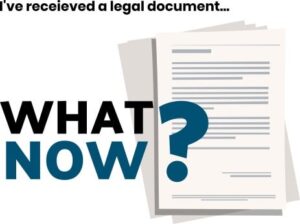Winding up your company means it will be placed into liquidation, its assets will be collected or realised, its creditors will be paid their debts as far as that can take place from the assets realised, and the company then closed.
Furthermore, as a director you have duties under the Act which require you to ensure that the Company does not trade whilst insolvent. A breach of this obligation may see you personally liable for debts incurred by the Company.
This is clearly a very serious matter requiring immediate attention. It is therefore absolutely critical that the recipient of a Statutory Demand urgently seek legal advice from an experienced professional to deal with it and the implications of it. You should contact a lawyer whether or not you believe you owe the debt, and whether or not you can afford to pay the amount stated in the Statutory Demand, because an experienced insolvency lawyer (as you will see below) may be able to set aside, dispute or otherwise invalidate the Statutory Demand on technical legal grounds.
A Statutory Demand must be correct in both form and substance as required by the Act.
A Statutory Demand must be:
- issued in writing pursuant to section 459E of the Act,
- in the prescribed form (509H); and
- accompanied by an affidavit (if required) regarding the debt. Serving a Statutory Demand on a company is usually the first step a creditor takes towards having a company who owes them money wound up and placed into liquidation. As above, this is often used as leverage to force the payment of an outstanding debt.
Service
Service is usually effected by sending the Statutory Demand by prepaid post to the registered office of the company. Service is deemed to have occurred on the fourth working day after it is posted unless there is evidence to the contrary.
A company receiving a Statutory Demand usually has 21 days to respond.
Failing to adequately respond to a valid and properly served Statutory Demand within the relevant time means that the company will be presumed to be insolvent, whether or not it is in fact solvent. That presumption has far-reaching consequences as above. It enables the creditor to file an application in the Supreme Court of Queensland or the Federal Court of Australia to have the company wound up in insolvency.
Once that process is commenced, it can only be halted by satisfying the demand (and those of any supporting creditors owed money), proving that the company is solvent, or by defeating the application on technical grounds.
If the application to have the company wound up is successful and the company is placed into liquidation, a registered liquidator will be appointed by the court to conclude or “wind up” the affairs of the company.
The liquidator will close the company’s business, sell its assets, collect any debts owing to the insolvent company and distribute any remaining funds to its creditors after payment of the liquidator’s fees and expenses. The liquidator will then de-register the company with the Australian Securities and Investments Commission (ASIC) meaning it will cease to be a legal entity.
The liquidator is also required to investigate the management of the company by its directors and report the findings to ASIC.
There is a very important duty placed on Directors to cease trading if the company is insolvent, which means it cannot satisfy its debts when they fall due.
It does not matter if the company is ‘balance sheet solvent’. Balance Sheet solvency describes an excess of assets over liabilities, even where those assets are tied up, invested or otherwise not immediately realisable. The true test of solvency in the insolvency context is being able to pay a company’s debts as and when they fall due. A Director should not allow the company to trade if it is insolvent in this context. Directors allowing the company to trade whilst insolvent and any other breaches of the Act which may give rise to potential offences, which the liquidator is a required to investigate and report to ASIC.
Important considerations
Because failure to respond to a Statutory Demand has such serious consequences for you and your company, the creditor issuing it must have strictly complied with all legal formalities under the Act for issuing and serving the demand. You could have the entire process invalidated if service was incorrect, or at least delayed significantly. Some of these considerations are set out below.
A Statutory Demand must be:
- issued in writing,
- in the prescribed form (509H); and
- accompanied by an affidavit (if required) regarding the debt.
How was the Statutory Demand served?
How you received the Statutory Demand is extremely important. You should make a note of how and when you received it and keep copies of all written communications you received with it. You could have the entire process invalidated if service was incorrect, or at least delayed significantly.
Are the creditor’s details correct?
Do you know the person or company who has sent you the creditor’s statutory demand? Compare the details on the demand with previous documents you have received from them. Do they make sense or is there some confusion?
Are your company’s details correct?
Has the person or company who sent you the Statutory Demand correctly described your company’s name, Australian Company Number (ACN) and registered address in the demand? This is very important, particularly in relation to your company’s ACN. However, a typographical error in your company’s address can also be significant. Again, you could have the entire process invalidated if service was incorrect, or at least delayed significantly. A winding up application was defeated for that reason in Victoria (Mills Oakley (a partnership) v Asset HQ Australia Pty Ltd [2019] VSC 98).
Were you aware there was a judgment against your company?
Does the Statutory Demand refer to a judgment against your company? If so, a copy of the judgment may be attached. It will have a court heading on it describing the court it was issued from, a claim number, the parties concerned with that claim and ultimately the amount the debtor has been ordered to pay. Are you familiar with those court proceedings, or is that the first time you became aware of them? You may be able to set aside or appeal the court judgment.
Does your company owe the creditor money or is it disputed?
If you are not aware of or familiar with the court proceedings or judgment, check your records to see if you or your company have ever had any contact with the person or company or organisation that issued the Statutory Demand. Situations have arisen where the wrong company has been sued for a debt because they had a similar name to the actual debtor, or share some similarity that has led to a mistake.
In the case of a debt claimed by a creditor, have you or your company dealt with the creditor before and according to your records and understanding, did your company still owe them any money? If there was a balance owing to the creditor, was there another reason you had not paid it? Did they owe your company a similar or larger amount of money? Was there a genuine dispute over the debt? Both these considerations can be used to set aside the Statutory Demand.
Is the amount claimed overstated?
Check your records to confirm whether the amount being claimed by the creditor in the Statutory Demand is the same as the balance you thought was owing. Has the creditor claimed in excess of what you thought was owing, or in some other way misrepresented the true debt (if any)??
You may have the options set out below
As you can see, there are many important considerations to be examined before responding to a Statutory Demand. Investigating these considerations and gathering information to identify any errors in the demand takes time but is critically important to survive the process. We therefore urge you to consider those matters as soon as possible because they will determine your options to respond to the Statutory Demand.
In broad terms, your options are:
Pay the claimed amount
To pay the amount claimed in the Statutory Demand within the relevant time in full.
Settle the amount
To arrange with the creditor who issued it to settle the amount claimed perhaps by instalments.
Request a withdrawal
If the Statutory Demand is clearly defective, or there is another compelling reason why it should be set aside, request that it be withdrawn within the relevant time.
Apply to Supreme Court
To apply to the Supreme Court of Queensland to set aside the Statutory Demand.
If the information in the Statutory Demand is completely accurate and unchallengeable, the first two options are the appropriate one’s for you to consider.
If your company does not currently have the financial means to pay the full amount claimed, and the creditor will not agree to an informal arrangement to settle that amount, there are formal options available under the Act which can achieve that outcome without risking your company going into liquidation. If, the Statutory Demand is not accurate or has not been served properly, you may be able to request that it be withdrawn by the creditor.
Alternatively, you can apply to set it aside on these grounds:
- enforcement of the judgment upon which the demand was founded had been stayed or suspended at the time the Statutory Demand was issued or served;
- there is a defect in the Statutory Demand and the defect will cause substantial injustice to your company;
- the amount claimed in the demand is overstated;
- your company has a claim against the creditor exceeding the amount demanded; or
- there is a genuine dispute about the debt being claimed in the Statutory Demand.
Insolvency is a technical and complex area of law and it is critically important to obtain legal advice if you believe that the Statutory Demand or its delivery was flawed or incorrect as there may be grounds to set aside the Statutory Demand.
Setting aside the Statutory Demand will prevent your company from being presumed to be insolvent and the creditor who issued the demand relying on that presumption to take steps to have your company wound up.
Apply for an adjournment of any winding up proceedings.
A creditor is required to commence winding up proceedings within 3 months of the expiration of the Statutory Demand and winding up proceedings must be finalised within 6 months of filing the Application to Wind Up the Company (may be extended in certain circumstances with leave of the Court). Once an application to wind up the proceedings has been filed, your options will be limited to applying to the court to adjourn the hearing of the winding up application to:
- allow the Company more time to reach an agreement compromising the debt or to pay the debt.
- obtain and/or prepare expert evidence for the hearing showing that the Company is solvent.
If you have recently received a creditor’s statutory demand and need help to urgently assess its ramifications for your company, one of our expert team of solicitors will be happy to help you. Contact Gibbs Wright today for a free and confidential initial consultation to explore your options and legal rights.




